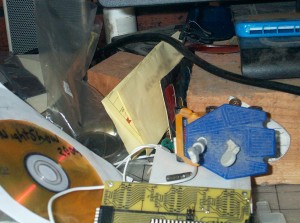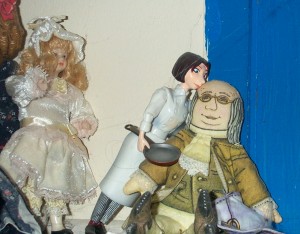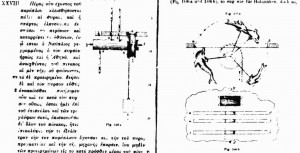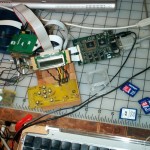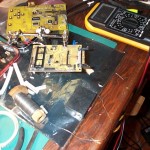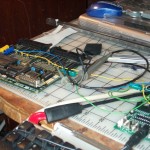The last few weeks have been a rather busy blur. This started with the Nova Albion Steampunk exposition. I just returned from mars. More specifically the Contact conference presented by Cultures of the Imagination.
Contact, is an interdisciplinary gathering of Anthropologists, Writers artist, Filmmakers and Engineers. The last few years this has been held on or near the NASA Ames Research Park in Mountain View, Silicon Valley. It may be easy to describe this as the oldest and best known SETI conference. This just may be an excuse for a lot of bright talented people to get together and party. No one has yet to see a little green man (or woman) so, there seems to be some job security for those who like to listen for them.
This year the conference was more focused on the anthropology side. Possibly due to the economy there seemed to be an absence of Science Fiction writers. So get out there and start buying more books. As a robotisist, I tend to hang out with the NASA engineers who get to drive sporty little rovers on the other planet. This is a fun group, and I get to compare how much dust collected on the toy rover I got when Spirit and Opportunity landed, to how much is on the real thing,
From Pixar, we had the showstopper of a presentation, The latest in photo-realism. With a series of stills, it was difficult to tell what was real and what was fake. The highlight was a 10 second clip from an introduction to what is possible. This could have been anyone recruited from a temp agency to give a short product pitch. That the product is the pitch makes it only all the more a little closer to the cliff called the uncanny valley. Masahiro Mori[1] proposed this theory as an explanation for the likes of Doctor Coppelia.
Sometimes it takes a strong pair of Doctor Coppelias’s rose tinted glasses to see into this. Even I have found some of my puppets and dolls a bit disturbing. I am not exactly sure what they are up to here. This does bring in some interesting connections to the need for 3D eyeglasses, to complete the illusion. I suggest that one should not get to attached to my friend Olympia. On the other hand frequent older readers to the main, Delectra.com site, have been able to use such rose and cyan tinted glasses to see into the precursor of Olympia, the doll sometimes known as Marianne Droz.
The most surprising Contact, I made at the conference, was with a Marine Biologist who has done some amazing studies of human dolphin communications. Pop culture films from the 1970s aside, this may be our first contact with a non human equally intelligent species. Something well known to the likes of Homer and the great engineer and puppet maker from Alexander, my own hero, Hero. Here is a snapshot of his take on clockwork dolphins, who take a liking to Ajax.
So leaving this fuzzy world of mars I next attended the AMICA meeting.
Now I love mechanical music, Those rocking rags and blaring marches from the 1910s and 1920s. This is much like fine scotch whiskey. It is an acquired taste. I also like Doctor Who, Puppet show and Mechanical dolls. My favorite episodes of this 40 something year old TV show involve these somewhat uncanny things. The more recent ones written by Stephan Moffatt. Recently he wrote about why actors from over the last 47 or so years should not return:
“… sometimes that can make your new and most cherished viewers feel excluded from the party. And Doctor Who has to absolutely be a brand new show…
…The moment it becomes something your dad wants with old codgers wandering about, it will die. It is not important to bring anything from the past. You could bring nothing back from the past ever again in Doctor Who and it would be fine.”
I kept thinking of this quote all weekend. “Something your dad wants.” Is this why some say Mechanical Music is doomed? Because it becomes about the music. Ironically, the last gasp of the first generation piano roll production ended with the Beatles in the late 1960s. These guys all passed on. The middle age kids of the time are now the old codgers of today. Ironically most of this generation do not like the blaring of John Phillips Sousa. But it is what they associate with going to the beach amusement park and hearing the rusty old squeezebox blare it out.
Now AMICA sometimes seems like one of these collections. Covered in dust an echo of a forgotten generation. The problem is that the older generation wants to preserve “Their way.” The conservative idea that the world does not change. That children are always the same and must be taught simple things before they become bored. Of course in this day and age, the Disney brothers would be locked up for frightening children and giving them nightmares.
Much of the broken fairgrounds junk was thrown in the trash. What remains is rare and sells for large sums. There are about a dozen mega rich collectors who hoard this stuff in their Mc Mansions, along with auto collections and the like. I say more power to them, the have preserved the world of their youth. Of course outside of places like San Francisco’s Museum Mequanic, children are not allowed to view these toys.
There are cultures where these older mechanical toys are taught to the children. According to one person I spoke with over the weekend, that many Americans are now working for these children. That there race is now somewhat smarter than our race. I do not agree with this assessment. It takes a lot of brainpower and intelligence to be ignorant and dumb and work the social welfare systems inside these tribal family groups.
Today those of us who are makers, some who identify in the steampunk moment, are creating new concepts from these trash heaps. I really wish there was a way, where Makers, Steampunks, Re-enactors and mechanical music enthusiast can come to a common understanding.
Now I have been spending the last month or three reading the history of the Panama canal before bed. This mess was the biggest engineering disaster the world has ever seen. The last of pharo’s gangs of labors toiling for the masters. Actually the canal is quite small, Smaller than San Francisco bay. Modern freeway projects move more dirt. and all that. So what does this have to do with mechanical music?
Well once the mosquitoes were abated by socialism, The white overloads who worked for Caesar Imperious , were able to create secret society clubs. These were all the thing back in the 1880s and such.
So I have decide to create the Secret Society of the Royal order of the Mechanical Masonic Sheep. Membership in this of course is secret. So only those who know that they belong can join. However this is an Open Source masonic order. So therefore any work done by the Mechanical Masonic Sheep, must be open for others to access. This by definition means that everyone is a member of my club. No one is or can ever be excluded.
The first rule is that there is not extortion to be had from other members. To counter this members must be helpful and donate information, to those who do not have it. No member can fine or tax any other member without just compensation. On the other hand members are free to contribute ideas time and material wealth to others. As everyone is automatically a member, this rule is completely voluntary. I am sure most will ignore it.
The tone of this order is modeled as a mash up of Mozart’s Magic Flute with Gilbert and Sullivan’s Iolanthe. So this is also a fairy masonic order. To keep things in line with the crazy weekend, Benjamin Franklin will be the patron of the order. Homer’s Odyssey the framework of the mythos. The god of the order are Isis and Osiris. And my own Palas Athena Governor. The bay Laurel is the official tree, and the rose the flower. Descartes is the philosopher of choice.
Of course this is all nonsense, most of the world is. I set out write something political in this blog and feed into the frenzy of the changing times we are witnessing. Instead I get more abstractinos from practical real world experence.
For me 100 years ago will always be the 1850s and 1860s. Because that was what I learned as a child half a century ago what one hundred years meant. 200 years was the 1770s which were exiting times in the world of mechanical automata, painting and just pure design aesthetic. There is a reason 2001 is my favorite film. I want my clockwork Heaven. The crystal spheres, silver gradients and the brass gears.
Now we find that 100 years is the age of the Panama Canal, The Titanic and ragtime music. A world many want to return to with a divided class labor force. You are as you are born. This is your cast. The height of the Raj of India. One god indivisible with justice for all. Not that I can improve on any of this. I decided a long time ago that I did not like the rotted well water of politics. This does not, invalidate my theory that with politics, is much like a well. That there must be a fair amount of brackish water on the bottom for the sweet water to flow on the top.
Drain the well of taxes and socialism too far and one is left with the bitter taste of bad water. Now I am rather selfish when it comes to politics and opinion, these are mine and You can not have them. Still I tend to be a liberal hawk. Probably from my upbringing inside the Silicon Valley industrial complex. Johnson’s Great society. How Taxes are supposed to work. What does it really matter after 100, a thousand or so of years, If people are lazy or not. Everyone contributes. Some philosopher said “to each according to his need.”
This is how the panama canal was built. How we went to the moon a half century ago. This is also how renaissance fairs, woodstock clones, burning man, science fiction conventions, Rock concerts, and a whole lot of successful things have and will be done. This is what happens when society collapses as the Media is us is soon. After reading Ken Follit’s Pillars of the earth, this may also have been how Cathedrals were built.
What is interesting, is that while there will still continue to be backlash at change, Some inspired some done by stupid methods. There are already forces at work, like the Royal order of the Mechanical Masonic Sheep. That counteract these. Much today would be like people in the 1920s refusing to use electric light, because god intended humans to see the light through candles and rush lights. Perhaps this is why some cultures would like to return to oil lamps. Rub them and the genie appears.
But the genie is already here. Some call this science. The problem I have as an abstract thinker, is that I have seen no evidence of the parental god. The one who punishes when bad and rewards the good. This is not to say that I do not have faith. Here again I am selfish, as my faith is not yours and you can not have it. Can god be simplified in the equation 2+2=4? Descartes though so, when he defined the sign for addition as the holy cross. The equals, shows the view of Solomon, with man below and god above.
So no matter what happens, god will always be with us in science. But should this be kept in ignorance? I am a Pan-deistic,Poly-theist. Or all the gods all the time. No one is right and no one is wrong. The real point from a conference like Contact is just that. What we have is each other, and after an almost infinite amount of time, rocks can sing to the sky, just as birds and fish can live together inside the imagination of the human or abstractly similar mind.
